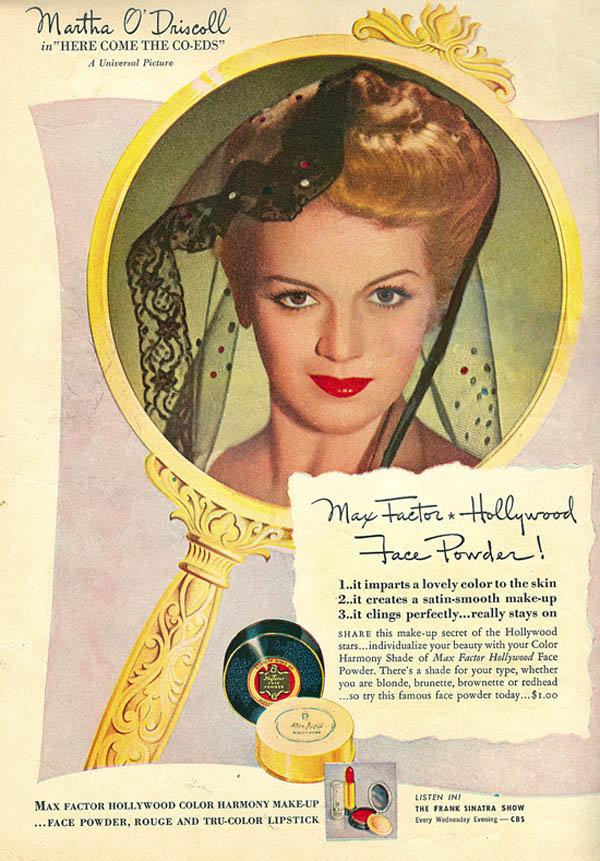Starstruck: Collecting Movie Star Ads
"Smack Dab In The Middle: Design Trends of the Mid-20th Century"
Naturally, the stars needed to be compensated. But what was fair? Millions? Thousands? Hundreds?
Nope. The "Max Factor Girls," as they came to be known, each received annual compensation in the heady amount of. . .one dollar.
That's right. One dollar. And the starry ladies who contracted with Mr. Factor were happy to have it. Over the years, Max Factor's movieland roster came to encompass a significant slice of Hollywood history.
Now, free publicity is nice. . .but signing over your image for just a dollar? Why were the stars of Hollywood's Golden Age so agreeable?
Well, because there were so many of them. Old-time Hollywood studios churned out movies more rapidly than Hormel churns out cans of Spam. Every evening on the silver screen, new faces were offered up for public consumption. Magazine ads like Max Factor's made sure those new faces had a chance to register, while at the same time making sure that familiar faces weren't forgotten. It was a dynamic return on a dollar's investment.
Soon, the stars shone brightly for an entire cosmetics counter's worth of glamour goodies. Of course, the majority of Hollywood stars, even dressed in gunny sacks, faces scrubbed with laundry soap, would still leave onlookers gobsmacked by their natural beauty. This was never mentioned. Instead, the message conveyed was simple: use Max Factor (or Woodbury, or Lux), and you could be just as lovely as Lana or as irresistible as Ingrid.
Once advertisers saw how favorably consumers responded to movie star endorsements, the race was on. Full-page, full-color cigarette promos had stars, ranging from Rosalind Russell to Richard Widmark, touting just how "mild" and "soothing" a particular brand could be. Jolene Shoes joined forces with bandleader/caricaturist Xavier Cugat for ads featuring a revolving door of fetching starlets. Art Linkletter pitched vegetables for Green Giant, Abbott and Costello touted Tums, and Ozzie & Harriet shooed away germs with Listerine. Puppeteer Señor Wences drank in the joys of Seagram's 7, while bandleader Lawrence Welk raised his baton in salute of the 1957 Dodge.
Some stars promoted their program sponsors. Bob "Pepsodent" Hope eventually ballyhooed everything from RCA Color TVs to Jolly Time Popcorn. Alfred Hitchcock balefully boosted Bufferin. Hearty vocalist Kate Smith sang the praises of baking with Swan's Down Cake Flour ("That girl," whispered one co-worker, "has a real sweet tusk").
By the mid-1950s, most stars "selling it" were doing so on TV, often on their own programs and for much more than a Max Factor dollar. Star-themed print ads eventually became the last bastion of once-familiar faces.
Fortunately, stacks of ad-laden magazines can still be found at estate and garage sales; prices run in the $5 to $20 range. If you're interested only in a single star, a ready-to-go ad is an option. Enterprising dealers buy up old magazines and dissect them, selling ads featuring specific performers at $5 to $10.
Paging through a magazine of the past is like opening a time capsule of mid-twentieth century popular culture. Let's riffle through a 1936 issue of Woman's Home Companion. On our way to the "star ads," we're happily waylaid by a wealth of recipes, decorating tips, and short stories. Then, that first ad appears. It's for Chase & Sanborn Coffee, sponsors of radio's Major Bowes' Original Amateur Hour. There's the Major himself and all his newly-discovered stars, including a vocal quartet, the "Hoboken Four". Wait a minute. . .who's that in the spotlight? Why, it's the group's lead crooner: skinny, smiling, and soon-to-be-famous Frank Sinatra!
In the words of Woodbury Powder, that definitely qualifies as "a bit of stardust magic. . . a flawless, film-star finish."
Donald-Brian Johnson is the co-author of numerous Schiffer books on design and collectibles, including "Postwar Pop," a collection of his columns. Please address inquiries to: donaldbrian@msn.com.

Donald-Brian Johnson
Donald-Brian Johnson is a nationwide columnist, and the co-author of numerous Schiffer books on design and collectibles. His most recent, "Postwar Pop," is a collection of his columns.














